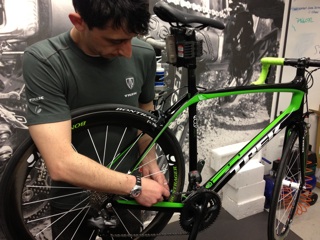Ever been to an event like the Halfords Tour Series, the Tour of Britain, or even a WorldTour event and found yourself casting an eye over the gleaming machinery leant against the tour bus?

If you’ve arrived early, or after a stage, you may have even glimpsed the mechanics hard at work, keeping their riders’ steeds ready to race and in a state of showroom cleanliness.
You may even have seen Peter ‘Spike’ Taylor at his work. One half of the Pro Tool School, a former colleague of Chris Boardman at British Cycling, preparing the bikes ridden to multiple Olympic glory by Team GB in Beijing, Taylor was in action most recently preparing the bikes of the Rapha Condor Sharp team for the frankly atrocious conditions of the Rutland-Melton CiCLE Classic, a race shortened by flooding and finished by just 24 of 155 riders.
Who better then to ask for tips on chain care and bike cleaning? Prior to preparing bikes for the Rutland deluge, Taylor was at work on the Tour of Normandy, preparing eight race bikes, a fleet of time trial machines, and spare bikes for the team car, every day on a week-long, eight stage race contested by some of the best teams in Europe.
Take a clean chain from storage
Chain care starts long before the event for Taylor. Clean, dry chains are held in storage coated in a water dispersant spray to protect them from airborne moisture. Weather conditions for the race will dictate further treatment. “At Rutland, when it was particularly bad weather, we used wax on the chain the night before to allow it to penetrate and dry into the chain and then used a wet lube on top of it. The end of result is that you end up with a chain that’s horrible and manky, but it’s still lubricated, which is a key thing.
“We took the trouble to wax first to penetrate in to the link, and because it’s a wax, once it’s dry it, will stay there, and the natural heat and friction from the chain will start to lubricate. The key thing is that it’s lubing from the inside out, rather than oil, which will lubricate from the outside in”
Cleaning a dirty chain
Taylor does not believe in splitting the chain unnecessarily, arguing that the process runs the risk of introducing a mechanical, even when connectors like SRAM’s Powerlink.
Instead, the rear wheel remains in the bike while Taylor cleans the entire drivetrain: chainrings, sprockets, and chain. He begins the procedure by filling an old drinks bottle with an eco-friendly, water soluble degreasant, and mounting it in the bottle cage attached to the frame. “If you wet the bike first, you’re too late. You’ve already introduced water before the degreaser can attack the oil and dirt on the chain to break it down,” says Taylor.
He uses a one inch paint brush, crucially with nylon bristles that won’t absorb the grime, to apply the degreasant to the drive train components. “We literally paint it onto the sprockets, and the chain and the chain rings,” says Taylor. “You can also use it very lightly on the braking surface of the rim. That gets rid of that horrible paste you get in bad weather.”
Cleaning the frame
With the degreaser applied, Taylor removes the wheels, fills a builder’s bucket with soapy water (hot if available), and dons a pair of sponge mitts, available for car accessory shops or DIY superstores, to protect his hands. “If you need to get your hands down behind the chain ring, or up into the frame between the forks, where you can catch your knuckles on things, these mittens are fantastic,” he says.
The soapy water is applied with brushes fitted with cactus hair, acquired in Texas by a friend. “Cactus hair doesn’t pick up any grease. We duck them in the water and pay particular attention to derailleurs, chain rings, the chain: they can all be cleaned with these soft brushes,” says Taylor. The brushes are equipped with long handles to save the mechanics’ backs. A dousing of cold water with a hose pipe completes the process.
‘Can’t-be-arsed-itus’
Taylor is a ‘massive advocate’ of cleaning, and teaches the principles at sessions held by his Pro Tool School. “We’ve coined a phrase in our workshop called ‘can’t-be-arsed-itus’. Cleaning your bike should take you five minutes,” he says. “People say they can’t be bothered and put it in the shed. Then they take it out of the shed, cover it in GT85 and go riding on it. All you end up with is a manky mess of chain and your grinding the chain and cassette to nothing. If clean it regularly, keep on top of it, you’ll have many, many miles of happy cycling.”
Tools of the trade
Taylor uses Finish Line lubes and products from the Juice Lubes brand, including the company’s Bearing Juice, which he says can be used safely on carbon frames and which he prefers to copper based grease.


